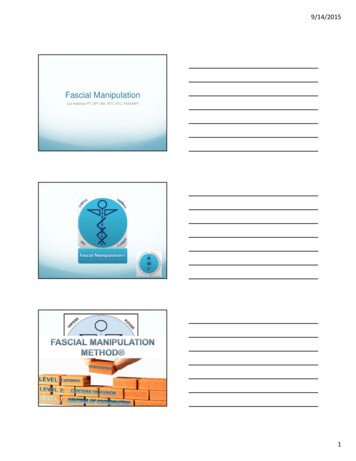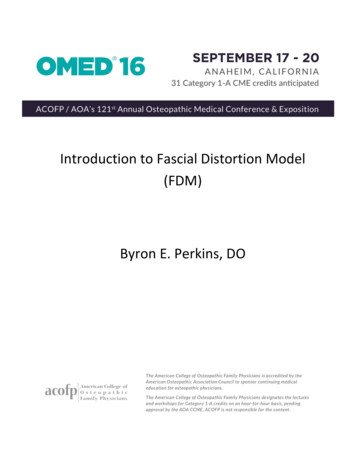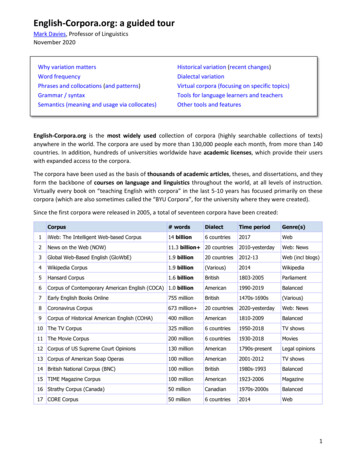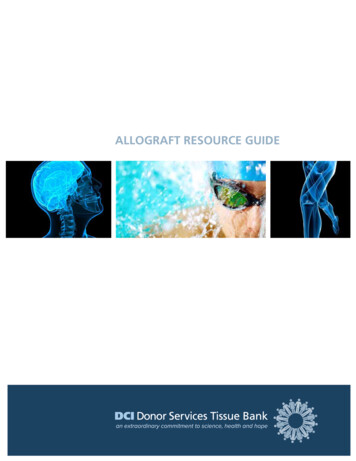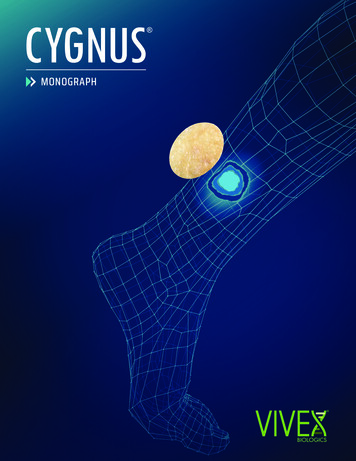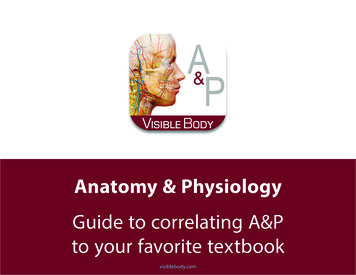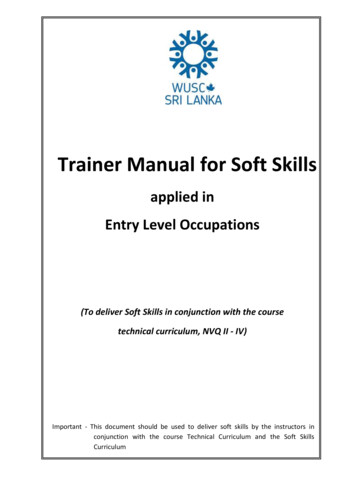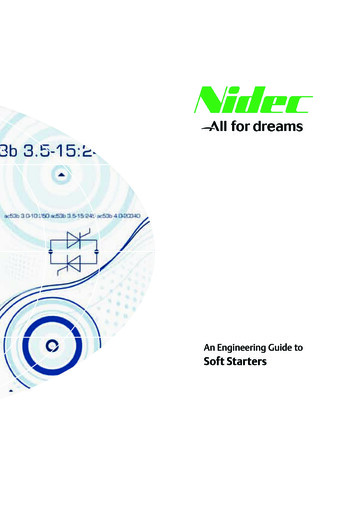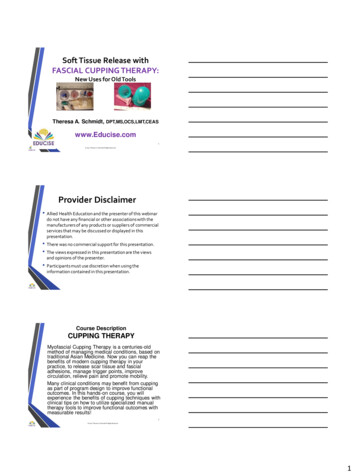
Transcription
Soft Tissue Release withFASCIAL CUPPING THERAPY:New Uses for Old ToolsTheresa A. Schmidt, DPT,MS,OCS,LMT,CEASwww.Educise.com1 2017 Theresa A. Schmidt All Rights ReservedProvider Disclaimer Allied Health Education and the presenter of this webinardo not have any financial or other associations with themanufacturers of any products or suppliers of commercialservices that may be discussed or displayed in thispresentation. There was no commercial support for this presentation. The views expressed in this presentation are the viewsand opinions of the presenter. Participants must use discretion when using theinformation contained in this presentation.Course DescriptionCUPPING THERAPYMyofascial Cupping Therapy is a centuries-oldmethod of managing medical conditions, based ontraditional Asian Medicine. Now you can reap thebenefits of modern cupping therapy in yourpractice, to release scar tissue and fascialadhesions, manage trigger points, improvecirculation, relieve pain and promote mobility.Many clinical conditions may benefit from cuppingas part of program design to improve functionaloutcomes. In this hands-on course, you willexperience the benefits of cupping techniques withclinical tips on how to utilize specialized manualtherapy tools to improve functional outcomes withmeasurable results!3 2017 Theresa A. Schmidt All Rights Reserved1
LEARNING OBJECTIVES Discuss the history and benefits of cupping therapyList indications, contraindications, andprecautions for cupping therapy Discuss the evidence based research for cuppingtherapy Discuss the application of cupping therapy aspart of program design to treat a variety ofclinical conditions to promote mobility andfunctional outcomes.4 2017 Theresa A. Schmidt All Rights ReservedAGENDA Introduction, history of negative pressure cupping,theory, equipment safety and infection control Oriental medicine theory and practice, historical andmodern Evidence related to cupping therapy, precautions,indications and contraindications, benefits Myofascial release concepts, scar release Medical cupping and demonstration: skin glide andscar release Cupping interventions for specific conditions Question and answer time5 2017 Theresa A. Schmidt All Rights Reserved62
Introduction from Dr. Theresa Schmidt7 2017 Theresa A. Schmidt All Rights ReservedCenturies-Old Methodof Managing Medical ConditionsYou saw it on the Olympian swimmers in the 2016 Games,on Michael Phelps, on the backs of actresses sashayingdown the red carpet8 2017 Theresa A. Schmidt All Rights ReservedHistory of Cupping Therapy“Baguan”9 2017 Theresa A. Schmidt All Rights Reserved3
Folk Medicine Remedy Ancient cups were hollowed horns or bones of animalsand bamboo plants, used to suck out toxins fromsnakebites and insect venom10 2017 Theresa A. Schmidt All Rights Reserved Asians Egyptians Greeks HebrewsHISTORICAL USE11TCMAcupuncturists use glass fire cups along with TraditionalChinese Medicine (TCM) to treat a variety of conditionsCupping is often combined with acupuncture needles,moxabustion, herbs and other traditional remedies124
USE CUPPING FOR FASCIAL RELEASE!GET A GRIP! Imagine how much easier it is using a tool to grip andelevate the skin and fascia! Save your hands and be ergonomically efficient withCUPPING!13ORIENTAL MEDICINE THEORY The whole is greater than the sum of the parts. All is connected Five Element Theory Chi or energy flow through the body in a system of channels ormeridians- 12 Excessive or deficient energy flow leads to dis-ease Balancing the Five Elements restores health14ORIENTAL MEDICINE PRACTICE Acupuncture Herbs Exercise Breathing Diet, nutrition Manipulation, cupping, BaGuan, scraping, Gua sha,TuiNa, Amma, Shiatsu, massage styles155
16ACUPUNCTURE THEORY Yin and Yang forces must balance for health, 6 divisions ofthe two form the 12 meridians through which the Qi flows 12 channels or meridians and governing and conceptionvessels carry energy Qi throughout the body, interconnectedin a balance Lung, colon, stomach, spleen, heart, small intestine,bladder, kidney, heart envelope, San Jiao, Gall Bladder, Liver17Bioenergy Flow Imbalances in the flow of creation and control indicate disease Acupuncture points may be overly sensitive Acupressure stimulates points on the energy channels torestore flow of Qi and blood, to balance the organ related tothat point/channel Cups are applied to points or tendino-muscle channels torestore Qi flow and balance186
19FUNCTIONAL VS STRUCTURAL Oriental medicine focuses on the synthesis of how the bodyparts interrelate in terms of energy and function, and restoringbalance for health Western medicine focuses on breaking down the body partsinto components, to be medicated or repaired individuallywithout regard to the whole, to restore health(Sohn, Amma Therapy, 1996)20217
MANUAL THERAPY TOOLSToday, manual medicine practitioners, doctors,therapists, massage therapists and trainers wantto save their hands and get a grip on skin andmuscle for soft tissue mobilization.Suction Cups, known as negative pressure cuppingtools,make excellent tools to save your hands andrelease abnormal tissue tension.22EQUIPMENT: Instrument-assistedsoft tissue mobilization (IASTM) Cups Lubricants Pumps Draping, gloves Disinfection materials Positioning and accessory devices23CUPPING TOOLS Bamboo, pottery- single use, not recommended, chance ofinfection Glass fire cups “fishbowls” Plastic cups Rubber cups Silicone cups248
CUPPING SUCTION METHODS Manual suction- silicone or rubber bulbs create negativepressure Rubber or silicone cups and toilet plungers Mechanical or electrical suction creates measurablenegative pressure in Pascals (Pa) to lift the tissue This course will address manual suction tools and other therapytools to facilitate mobility25RECOMMENDED CUPS For fire cupping, thick glass with rounded rims to glide overskin easily For silicone or plastic cups, thicker rounded rims allow greaterglide, some have flat rims for direct stationary suction Desire optimal vacuum effect with air-tight contact Requires lubricant for gliding cups to adhere effectively, notneeded for stationary26GLASS FIRE CUPS: caution! Glass Fire Cupping uses negative pressure for suction Heat the air inside the cup with alcohol wipe or otherflammable agent, (coconut oil) light just prior to application tothe skin, create a suction vacuum effect as the air cools andoxygen is used, the flame is extinguished just prior toapplication to avoid burns Timing is critical, to prevent burns Might not be insured by malpractice insurers279
SILICONE CUPPING TOOLS28SILICONE CUPSSilicone cups are made of relatively soft material to allowone to squeeze the cup, applying pressure to empty the airinside,then quickly place the cup on the skin,As the pressure is released, the vacuum effect anchors thetissue into the cup, allowing it to adhere to the skin, noburning requiredLubricant helps seal the cup edges to the skin, and allowsone to glide the cups while maintaining suction, oils workbest29PLASTIC CUPS & PUMPMechanical cupping is performed using plastic cups with movablevalves on top for use with a handheld or pneumatic/ electricsuction pumpThe valves and pump allow adjustments in degree of suction (Pascals) for light, medium and strong negative pressuresSome have magnets built in for acupuncture effects3010
Mechanical Suction Cups & Pump31TYPES OF CUPPING STYLES Wet- still used by TCM practitioners but high risk ofadverse events (Hijama) Small cuts are made on the skin for medicinalbloodletting, then stationary suction cups are placed todrain the body of stagnant energy and toxins, such asheavy metals High risk due to open wounds Most states do not allow wet cupping as part of PT, LMT,OT practice Wet cupping is not addressed in this seminar32Wet Cupping: Bleeding3311
TYPES OF CUPPING STYLES Dry- what we use for soft tissue mobilization Involves placing pressurized suction cups on the skin to draw thetissue into the cup to increase circulation, stimulate energy flowand tissue mobility/ stretching May be used with or without lubricants May be stationary-static or movable/ gliding May be temperature controlled for fire cups3435TYPES OF CUPPING STYLES Moxa: using mugwort herb heated to apply to acupuncturepoints, under the cups Herbal cupping, using herbal oils, tinctures, preparations, teasor poultices inside the cups Flash cupping- 1-2 second application and removal of fireheated cups Water cupping, filling cups with heated water and applying toskin3612
TYPES OF CUPPING STYLES Needle cupping- placing acupuncture needles in the skin, thenapplying suction cups over the needle Magnet cupping- include a magnet in the cup to stimulate theskin Aquatic cupping- placing suction cups when body part issubmerged in water37SAFETY Infection control: ensure cups are clean, for silicone, washwith antimicrobial soap and hot water Maintain sanitary conditions for your treatment area,proper handwashing Never use cups over broken, irritated, abnormal ordamaged skin Never leave clients alone when cups are engaged, keep aneye on the response38SAFETY Manage the amount of negative pressure carefully, too stronga suction may damage the skin or cause the superficial layersto separate from the dermis Avoid leaving the cups in place for more than a 10-15minutes to limit the development of bruising/ reddish/purplediscoloration Use ample lubricant to allow gliding, sliding3913
TYPICAL CUPPING MARKSDark purple marks- a normal reaction whencups left in place several minutes, differs withage, skin type, color, and level of toxicity40ADVERSE REACTIONS Infection- unclean cups, hands, broken skin, crosscontamination (burns if firecups) Blistering- too strong suction or cups left on too long Hives- some people have high inflammatory reactions to softtissue mob STM Pain- typical with gliding if tissue is tight, may sting or hurtduring the stretching414214
INFECTION CONTROL INFOWebsites for sterilization/ disinfection: Centers for Disease Control and Prevention: http://www.cdc.gov/ncidod/dhqp/sterile.html Food and Drug .html Environmental Protection m University of North rg43CDC RECOMMENDATIONS “Medical equipment surfaces (e.g., blood pressure cuffs,stethoscopes, hemodialysis machines, and X-ray machines)can become contaminated with infectious agents andcontribute to the spread of health-care–associated infections248, 375. For this reason, noncritical medical equipment surfacesshould be disinfected with an EPA-registered low- orintermediate-level disinfectant. Use of a disinfectant willprovide antimicrobial activity that is likely to be achieved withminimal additional cost or work.” From:https://www.cdc.gov/hicpac/index.html44CDC CATEGORIESTo reduce risk of transfer of pathogensInstruments are categorized as Critical- pass through tissue and vascular Semi-critical- may contact non-intact skin or mucusmembranes Non-critical- contact intact skin Cups are semi-critical since we cannot guarantee skin isfully intact4515
CUP INFECTION CONTROL“Cups (made of glass or plastic), scraping spoons, gua sha toolsand any other equipment which has been in contact withintact skin only are non-critical items and can be reprocessedby cleaning and/or disinfecting according to the NHMRCGuidelines. NHMRC 2010, pp. 34-45, available hand-hygiene”46HIGH LEVEL DISINFECTION ORSTERILIZATION REQUIRED Use high level disinfection of cups for re-use FDA regulates disinfecting agents used in a staging areaseparate from patients Use immersion in Sporox or hydrogen peroxide Visit www.pdipdi.com for info47Disinfection Procedure for Cups Wash with soap and water “Immerse instruments in 7.5 % Hydrogen peroxide solution:Sporox II Sterilizing and Disinfecting Solution 30 minutes: high level disinfection 6 hours: complete sterilization [Note: hydrogen peroxide sold in pharmacies is not strongenough at 3%]” (From: Standards Guasha Baguan.pdf)4816
KEEP EQUIPMENT, CUPS, SKINAND HANDS CLEAN49CONTRAINDICATIONS Skin must be intact, not broken or infected Do not use over any skin irritation Do not use on juvenile or elderly skin Do not use if skin bruises easily, with bleeding disorders(anticoagulant meds/ bleeding tendencies/blood thinners) It is not advised for use during pregnancy Don’t use with patients who cannot provide informedconsent50CONTRAINDICATIONS Skin wounds, lipomas, allergies, moles, cancer, purpura,ulceration, eczema, psoriasis Sunburn, pimples, swelling, abrasions, rash Fever, convulsions, cramps, chemotherapy Large superficial blood vessels, varicose veins, spider veins,pulses Poor circulation or severe heart disease Unhealed fracture or instability Leukemia, hemophilia, vasculitis, thrombocytopenia5117
CONTRAINDICATIONS “ When psoriasis was treated by cupping therapy,subsequent development of the Koebnerphenomenon at the cupped sites was observed.Cupping can induce both epidermal cell injury anddermal vascular damage in terms of abrasions,ecchymosis, and purpura.108 ” (skin lesions due totrauma) 63/52ABNORMAL MARKS: PURPURAFrom: By James Heilman, MD - Own work, CC BY-SA d 1185719753CONTRAINDICATIONS areas of poor circulation diabetic, thin or fragile skin over areas with abnormal sensation or lack of sensation,neuropathy over trachea, near eyes, genitalia cases of severe edema cases of heart disease Post-surgical scars require medical clearance prior to cupping Get medical clearance for any condition you are unsure of5418
55INDICATIONS56CUPPING BENEFITS Mobilize scar tissue, myofascial release Soft tissue mobilization, improve ROM Decrease toxins Increase muscle and fascial mobility57 2017 Theresa A. Schmidt All Rights Reserved19
CUPPING BENEFITS Reduce painful trigger points Increase blood and lymph circulation Improve functional mobility Some studies show improvements in other conditions,this seminar focuses on musculoskeletal andmyofascial disorders58 2017 Theresa A. Schmidt All Rights ReservedMYOFASCIAL SOFT TISSUEMOBILIZATION IMPROVES Areas of excessive tension, muscle, skin, and fascialstiffness or restriction, Limited range of motion (ROM) Mature scars and cicatrix Painful trigger points Postural asymmetry due to fascial and muscle tension Tissue texture stiffness or adhesion59MYOFASCIAL CONCEPTSFascial anatomy courtesy of Jean Claude Guimberteau,with permission, see more at:http://www.endovivo.com/en/6020
FASCIA RESEARCH CONGRESS“Fascia is the soft tissue component of theconnective tissue system that permeates thehuman body.”“Fascia extends to all fibrous connectivetissues, including aponeuroses, ligaments,tendons, retinaculae, joint capsules, organ andvessel tunics, the epineurium, the meninges,the periostea, and all the endomysial andintermuscular fibers of the myofasciae.” (Huijing,et al, p. 2)61FUNCTION OF FASCIA Compartmentalizes and surrounds allstructures, as an interconnected,contiguous webfully Maintains posture: Fascia will adaptivelyshorten in whatever position the body is kept Observe posture to detect wheremuscles/joints may be restricted62FUNCTION OF FASCIA Aids circulation- forms interstitial spaces,provides the fluid matrix for support ofimmune cells (Pert, Engler, Passerieux,Pukhlyakova ) Influences cell metabolism: fascialcompartments contain plasma, interstitialfluid, and lymph in the ECF: matrix forchemical mediators, cytokines, peptides6321
FUNCTION OF FASCIA Mechanotransmission: transmits and adaptsto mechanical stresses, transmits torque andtension three dimensionally (deBruin) Vectors of tension travel 3-D through thefascia to distant regions where the tensionmay transit pain or affect biomechanics,resulting in altered mobility (Travell) Relays and stores information(Oschman, pp 213-214)64FUNCTION OF FASCIAFascia allows gliding by separating structuresand transfers force while connectingstructures65FUNCTION OF FASCIA Electromagnetic transmission agent (Oschman,pp 213-214) The energy meridians or channels thatconnect the acupuncture points are found inthe fascial planes (Chaitow, 2012, Ahn, in Huijing, 2012) These are areas of demonstrated changes ingalvanic electrical skin resistance in the body Positive correlation between acupuncturepoints and fascial planes (Huijing)6622
FUNCTION OF FASCIA Deposits collagen to heal injuries and to rebuild thebody on a regular basis Collagen is a dense connective tissue protein whichgives strength to the tissues During abnormal conditions such as stress, trauma orcertain diseases, the body deposits too much collagenin a disorganized fashion, leading to adhesions/scartissue and dysfunction67Strolling Under the Skin by Dr. Guimberteauwww.endovivo.com/en/ with permission68VIDEO: Muscle AttitudesMore fabulous fascial anatomy on youtube, free!From Jean Claude Guimberteau, MDReference:https://www.youtube.com/watch?v YqqB4NVtAvE6923
WHAT HAPPENS DURING THEHEALING PROCESS?After tissue damage, inflammatory process Fibrosis: scar tissue formation Fibrositis- inflammation of fibrous tissue with hyperplasia Collagen is laid down in haphazard fashion Gradual remodeling along lines of stress70Release Scar Tissue and FascialAdhesions71WHAT CAUSES RESTRICTIONS? Macrotrauma- strains, sprains, contusions Microtrauma- Repetitive strain, overload Mechanical- Improper posture, scoliosis, inefficientergonomics Neurological- compression neuropathy, neural sensitization,spasticity Disease- infections, SLE, CT disorders Endocrine abnormalities- thyroid, estrogen deficiencies Nutritional- minerals, vitamin deficiencies Sedentary behavior- muscle imbalance(Yap, 2007)7224
PHYSIOLOGIC RESPONSE TOMFRIncrease in: circulation, oxygen, waste removal, lymph & venous drainage, temperature, relaxation flexibility, elasticity7374HAVE YOU TRIED SKIN ROLLING? Pinch the skin in between your fingers gently Lift the skin away from underlying tissue Press and roll it away from you (or toward you), rolling itbetween your thumbs and fingers like rolling a pill, don’t let itslip away Assess the amount of lift or adherence It may feel painfully pinchy or even burning when very tight,inform patients Usually feels good when normal7525
SKIN ROLLING AND GLIDING Try it on the spine, abdomen, upper and lower extremities What is different about various regions Note the difference in mobility near joints compared to overmuscles Can you roll in all directions? Compare sides Can you pinch and lift the skin or is it adherent?76Ultrasonographic Changes with MFRSkin Rolling/Pressing Pohl: high resolution-high freq. ultrasound (22MHz)4 mm subcutaneously to echo collagen 10 cases, compared normal to restricted areas Did MFR to both, No pre/post differences in unaffectedareas collagen distribution changed in affected areaspostMFR MFR changed collagen density and tissue tension Dermal densifications reduced, fibroblasts relaxed (Huijing, FRCIII p. 208-215)77WHAT DOES IT FEEL LIKE?NORMAL: Clinically, we note that normal tissues have elasticity atthe endrange: there is a slight bounciness when you take up all the slack in the tissues and oscillate. It is notpainful. Joint have normal ROM in the area, if ROM is limited,there is a restriction in the region.7826
WHAT DOES IT FEEL LIKE?RESTRICTED: In restricted tissues, there is no elasticity, the motion justends abruptly. No bounce. There is less quantity of glide available. It may be painful! Feels stuck or stiff. Compare bilaterally to perceive the quality and quantityof motion.79WHAT IS NORMAL?Be sure to examine motion on many different peopleto develop a sense of what is normal in variouspopulations.80MEASURE SKIN GLIDE & ROMAdherometer: instrument to measure skin glide, like atransparent gridEasier: use a ruler to measure the excursion of the skin as youmove it in all directions, superior, inferior, medial, lateral andoblique anglesDocument the mm of skin mobility and joint goniometric ROMpre- and post- interventions8127
CUPPING AS A TOOLFOR MYOFASCIAL RELEASEPlungers make interesting tools, when clean!82 2017 Theresa A. Schmidt All Rights ReservedPOSITIVE OR NEGATIVEPRESSUREPositive pressure or compression is typically used inmassage and myofascial work, pressing into the tissue,pulling while pressingNegative pressure or distraction is used in cupping toseparate fascial layers and pull the tissue instead ofpushingVarious tools are used for both styles of release83NORMAL AFTER-EFFECTS OFCUPPING Erythema: redness Ecchymosis: purple coloration Edema: puffiness Warmth8428
MYOFASCIAL RELEASE MFRTECHNIQUE PRACTICEIdentify the mobility or functional deficit: Move the skin in all directions Imagine a clock or compass- directions Compare sides, compare to normative values Document the limitation or restriction (mm) Measure joint ROM and document Measure the mm of skin mobility85 2017 Theresa A. Schmidt All Rights ReservedMYOFASCIAL STRETCHING,MOBILIZATIONPlace your hand, fingers, or palm on the tight area, take upthe slack to strain (stretch)Stretch the tissue in the direction of greatest limitation(unless it is painful to do)Hold it until the tissue gives, lengthens, and softens, andwarms up (may be 1-2 mins.)As it gives, take up the slack and perform another stretchinto the barrierRepeat 3-5 reps until greater motion is observed868729
FASCIAL RELEASE USING CUPS/PLUNGERS to STRETCH SOFTTISSUE/ FASCIAInstead of using your hands and fingers to grip the skin andmuscles to lift the tissue, use the cup to suction it up awayfrom the deeper structures, to stretch the fascial layersIt is more energy efficient!Less tiring, saves your hands!For even better grip, wear gloves88CUPPING TECHNIQUES In this course, we will focus on using cups as tools forIASTM, increasing mobility to get a purchase on the tight tissue and perform astretch to engage the barriers, to lengthen the shorttissue, skin, fascia or muscle899030
TYPICAL ERYTHEMA RESPONSE91INTRO TO ?v ViWRam1V4Zs92PRECAUTIONWhen practicing at first, do not leavethe static cup on in the same placefor greater than 1-2 minutesYou must discover how long eachperson takes for their skin to changecolor, we do not want to leave largebruises when just beginning topractice!9331
94PRACTICE WITH OTHER PEOPLE Repeat the same procedures on two other people to notehow different skin types react to the cupping intervention Use 2-3 different clean cup sizes Try stationary and gliding cups Avoid repeating the cupping on the same area, use anew area to avoid over-stretching and excessive skinsuction, leading to more redness.95CLINICAL APPLICATIONS9632
PRESSURE AND SIZECONSIDERATIONS97MECHANICAL EFFECTSIZE MATTERS!Tham showed larger cups produce maximum stress, alongan axis passing through the cup center (Tham, 2006) Skin compresses under the cup rim, the area aroundperiphery tenses Tensile stresses are greatest inside the cup rim, and at thecenter, affecting into the muscular layer(Tham, 2006)989933
CUP DIAMETER MATTERS! Start with small to medium diameter cups to test clientresponse There are greater skin-surface displacements and greaterunderlying tissue stress with larger diameter suction cups(Kravetz, 2004)100RIM SHAPE MATTERS Use rounded rolled rims, especially with gliding cups Sharper rims are more painful and produce greatercompressive stresses(Kravetz, 2004)101TIME MATTERS! In a study by Zhao, et al., 34 subjects were tested at a dozensites on the back to determine the effect of duration ofstationary cup placement, 10, 20, 30 mins Time had a significant effect on color of the marks(Zhao, 2009)10234
PRESSURE IS ON Greater pressure results in significantly more redness orpurple marks with cupping Zhao used -400, -500, -600 and -700 hPa pressures tocompare results in skin color Pressure of -400hPa caused marked ecchymosis Greater pressures increased darkness of the color(Zhao, 2009)1 hPa 1 millibar pressure103104EFFECT OF CUPPING10535
IMPROVED CIRCULATION& RELIEF OF PAIN106 2017 Theresa A. Schmidt All Rights ReservedEFFECT ON CIRCULATIONTensile stress development in the skin layers leads tohyperemia, capillary vasodilation and rupture,producing the ecchymosis marks on the skin as the bloodescapes into the surrounding tissues(Rosenfeld, 2016)107CIRCULATION INCREASES Observe the skin prior to cupping Note the gradual reddening of the area under the cup The longer duration of application, the more blood is broughtto the area, resulting in deeper redness When cups are left for several minutes, erythema or bruisingmarks form as capillaries spill blood into the superficial regionsof the skin10836
EFFECT OF CUPPING ON SKINTEMPERATURE Research shows a significant temperature changesecondary to cupping. Observe the temperature of the skin pre and postcupping on your partner If you have a skin thermometer, you can measure thetemperature change109CUPPING MANIPULATIONAs a soft tissue manipulation,cupping activates mechanoreceptors, and“will stimulate the inhibitory receptive fields of corticallyprojecting multi receptive dorsal horn neurons or provokediffuse noxious inhibitory controls”Stimulates A beta fibers to reduce pain input(Rozenfeld, 2016)110RELAXATION EFFECT Musial reported a relaxing effect of cupping therapy Stress reducing effect(Musial, et al., 2013)11137
PAIN REDUCTION Counterirritant action of cupping pressure Gating of pain Neuromodulation of pain Production of endorphins112PAIN NEUROMODULATION Neural mechanism theory of acupuncture Activation of small diameter nerves leads to release ofendorphins, serotonin or cortisol and monoamines, chemicaltransmitters that block pain messages or gate the pain(Rozenfeld, 2016)113PAIN MEASUREMENT VAS Visual Analog Scale, from 0-10, measures the painexperience 0 10 Zero is no pain Ten is the worst pain imaginable Most common method to document pain11438
NOT RECOMMENDED!115NRPS: TRY IT FOR YOURSELFNumeric Pain Rating Scale: same 0-10 Shown valid and reliable in over 20 studies Measure the pain of a trigger point pre and posttreatment using the cupping method Find a TP on your partner, get a number Apply the cup for 30 seconds Measure the pain at the point again116MANAGE PAINFUL MYOFASCIALTRIGGER POINTS11739
WHAT ARE TRIGGER POINTS?Abnormally hyperirritable areas of the muscle and/or itsassociated fascia, that are painful to compression, refer pain toregions distant from the palpated site, are present in taut ropybands of muscle, and often respond with a twitch or snappingsensation(Dr. Janet Travell, MD)118 2017 Theresa A. Schmidt All Rights ReservedEFFECT ON TPsFousekis et al. RCT: 70 soccer players with low back TPsIntervention: 3 IASTM, (instrument assisted STM) or staticcupping to 3 TPs for 5 mins. or 3 tx. ischemic pressure vs.controlResult: significant decrease in pain in all treatment groups,greater results with IASTM vs. controls(Fousekis, et al., 2016)11912040
EFFECT ON FIBROMYALGIA (FMS) Lauche et al., studied 141 people with FMS in RCT of usualcare, sham or cupping Given 5x 2x/wk pneumatic glass cupping with 4-8stationary cups for 10-15 mins. to upper/lower back Significant pain reduction and improved quality of life after18 days cupping vs. usual care, not different from sham (Lauche, et al., 2016)121EFFECT ON NECK PAIN & DISABILITY &QUALITY OF LIFESaha, et al., RCT of 50 people with nonspecific neck paingiven5 gliding cup massages 2x/wk x 3 wks vs. control of usualtreatmentResults: Reduced pain scale, (VAS) decreased pain onmovement, improved quality of life, and reduced functionaldisability(Saha et al., 2017)122EFFECT ON NECK SHOULDER PAIN Chi et al., RCT studies changes in skin surface temperature SST,Pain VAS, and BP in 60 subjects with chronic pain. Cupping vs.control resting Fire Cupping 10 mins per side with 4 cm cup at 3 acupuncturepoints in neck and shoulder (SI15, GB21, LI15) Result: Signif increase in SST and reduction in VAS in cuppinggroup, small decrease in BP in cupping group (Chi, et al., 2016)12341
SYSTEMATIC REVIEW OF CUPPING Cao reviewed 6 databases of 135 trials on cupping from1966-2014, chose 8 studies on 11 diseases Result: cupping and cupping other interventionsproduced better outcomes for improved pain, facialparalysis and acne than medications or otherinterventions alone(Cao, et al., 2015)124 2017 Theresa A. Schmidt All Rights Reserved125 2017 Theresa A. Schmidt All Rights ReservedAPPLICATION OF MEDICAL CUPPING126 2017 Theresa A. Schmidt All Rights Reserved42
PREP CLIENT Interview, check for contraindications Examine, determine problems Set goals for session Provide informed consent Give handout explaining expectations and results of cupping,meaning of the marks on the skin Some clinics require a release form127PREPIdentify the affected region: TPs, tight muscles, limited joint ROM, fascial restriction, loss ofskin mobility, scars Initially apply where it is easiest to work: over fleshy or muscularareas: erector spinae, gluteals, quads, hamstrings, gastroc, biceps,triceps, wrist/finger flexors and extensors, palm and sole128PREP CUPS Prepare the cups. Disinfect the cups with soapy warm waterand soak in the CDC recommended hydrogen peroxide solutionas directed. Dry thoroughly. Have a selection of at least 3 sizes of cups to treat differentbody parts. Smaller openings for the hands and feet,
practice, to release scar tissue and fascial adhesions, manage trigger points, improve circulation, relieve pain and promote mobility. Many clinical conditions may benefit from cupping as part of program design to improve functional outcomes. In this hands-on course, you will experience the benefits of cupping techniques with
